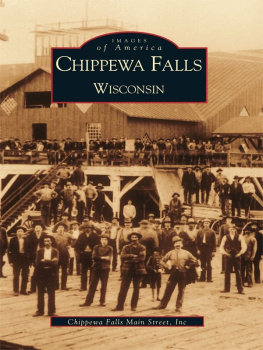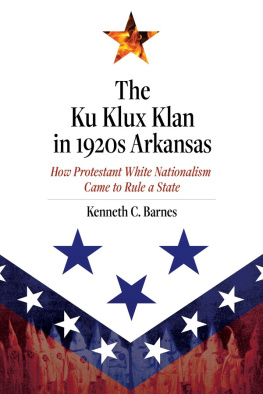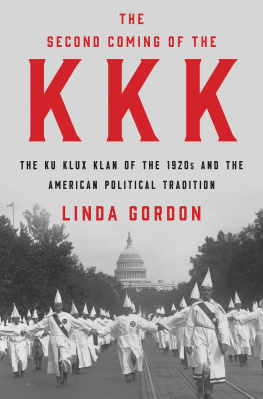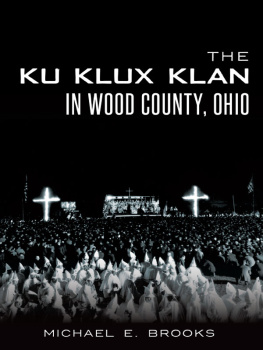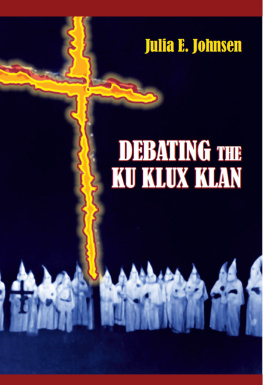


Published by The History Press
Charleston, SC
www.historypress.com
Copyright 2020 by John E. Kinville
All rights reserved
Front cover: Grey Eagles near Chippewa Falls, circa 1927. Authors collection.
First published 2020
E-book edition 2020
ISBN 978.1.43966.904.4
Library of Congress Control Number: 2019951877
print edition ISBN 978.1.46714.481.0
Notice: The information in this book is true and complete to the best of our knowledge. It is offered without guarantee on the part of the author or The History Press. The author and The History Press disclaim all liability in connection with the use of this book.
All rights reserved. No part of this book may be reproduced or transmitted in any form whatsoever without prior written permission from the publisher except in the case of brief quotations embodied in critical articles and reviews.
To Mom and Dad, for instilling empathy and tolerance.
CONTENTS

Original records from the Chippewa Falls unit of the WKKK, including meeting minutes, financial records and other ephemera. Private collection.
PREFACE
My journey to develop The Grey Eagles of Chippewa Falls began as a young man in the Lake Hallie and Chippewa Falls region of western Wisconsin. I routinely heard stories about the Ku Klux Klan in the area, including clandestine meetings, elaborate ceremonies, picnics and chicken dinners and crosses burning atop the few nearby hills. Aside from scattered oral accounts, little tangible evidence remained from their presence in the 1920s and 30s
While studying as an undergraduate at the University of WisconsinEau Claire, I came across a set of documents within the universitys archive that changed my life forever. The file was named Women of the Ku Klux Klan 14 (Chippewa Falls, Wis.), 1926-1931. As I thumbed through each page, I was stunned. The cache recorded the activities of the women of the Ku Klux Klan unit from Chippewa Falls. It included the biweekly inner workings of an organization known for its intense secrecy. Included were financial records, regional bulletins, national correspondences, official publications, a membership list, miscellaneous ephemera and a written set of minutes from fifty-eight meetings. Nearly sixteen years later, I have finally put my interest in this topic into writing.
ACKNOWLEDGEMENTS
This book would not have been possible without the support of the Wisconsin State Historical Society, Chippewa County Historical Society, Chippewa Valley Museum, Dunn County Historical Society and the University of WisconsinEau Claires special collections department.
Special thanks to John Rodrigue at The History Press, John and Carolyn Kinville, Mike and Tristi Crawford, Kim and Mary Jane Henderson, Chris and Shannon Elwell, Orrin and Naomi Todahl, David and Sandra Martineau, Mark and Lori Isaacson, Dylan Helwig, Tamara Harris, Alondra Harris, Zach Elbert, Brian Curran, Tucker Melssen, Angela Gudmanson, Scott and Tammy Tillotson, Patrick and Toma Kinville, Jim and Claudia Kinville, David and Barbara Kinville, Joe and Carolyn Kinville, Will and Abbie Steiger, Michael Kramer, Matt and Leya Hoy, Anya Schreiner, David H. Raihle Jr., Connie Zook, Sheila Hansen, Kris Taylor, Judy Baier, Winifred Jensen, Amanda Hill-Hable, Jeff at atlantarelics.com and the many grandchildren of the Grey Eagles who helped me get this book across the finish line.
I want to recognize the teachers, professors and support staff of the Chippewa Falls School District, University of WisconsinEau Claire and the University of WisconsinRiver Falls. Without your dedication and love for learning, I would not be the person I am today, especially John P. Kaminski, Oscar Chamberlain, Susan Krueger, Kurt Leichtle, James Oberly, Jane Pederson, Roger Tlusty, Robert Gough, Selika Ducksworth-Lawton, Tom Frederick, Roger Thompson and Darrin Ekern.
Lastly, none of this would be possible without the loving support and patience of my family, including my children, Jack, Jonathan and Savannah, as well as my cats, Huey, Ghost and Lizzie. My wife, Kara, deserves the biggest thanks of all, as she never once doubted my abilities in completing this book. She was a steady supporting partner throughout all phases of the project.
INTRODUCTION
While much is known about the mens Ku Klux Klan of the 1920s and 30s, the same cannot be said for its female membership. Due to the absence of detailed or comprehensive historical evidence to work from, little is known about the day-to-day inner workings of the female Klavern. As a result, much of the historiography has centered on the activities of the men. In 1987, Professor David Chalmers, nationally renowned author of Hooded Americanism: The History of the Ku Klux Klan, wrote the most comprehensive history of the mens Klan. Chalmers fifty-state focus covered the Klans postCivil War origins, its rebirth and meteoric rise in the 1920s and, finally, the postWorld War II fight against racial integration. Unfortunately, Chalmers coverage of the Womens Ku Klux Klan was limited to brief appearances within the sprawling volume.
In 1991, Professor Kathleen Blee published Women of the Klan: Racism and Gender in the 1920s. Considered the most exhaustive book on women of the Ku Klux Klan to date, Blee meticulously revealed how the womens order was not incidental to, nor subservient to, the directives of the mens Klan. Instead, Blee unveiled a complex organization of like-minded, patriotic women who fought passionately for social improvement through charity work and social causes like temperance, womens suffrage, public education and strong religious observance as being vital to a stable home and society.
Paradoxically, this nativist yearning for an improved 100 percent American society, which was rooted in their supposed adoration of freedom and the U.S. Constitution, took the form of a malicious ideology featuring a potent mixture of anti-Semitism, racism and xenophobia. Similar to their male counterparts, the members of the WKKK were fearful and antagonistic toward nonwhites, non-Protestant Christians and violators of the nations anti-alcohol Prohibition laws. Across the nation, the primary targets of the WKKK were African Americans, Catholics, Jews, socialists, immigrants, labor unions, bootleggers and any other person who was deemed unworthy of the label 100 percent American.
While sensational headlines of horrific and brutal acts of the male Klan appear ad nauseam throughout the 1920s and 30s, the WKKK received little negative national or regional headlines from the white press. In her book, Blee uncovered a womens organization filled with a more nuanced experience than its male counterpart. For all intents and purposes, the female members of the Klan were more charitable, law-abiding and committed to reflecting the positive ideals preached by both the KKK and the WKKK.
Even their anti-Semitic, racist and xenophobic views materialized differently than those of the men. Rather than overt physical violence, which were salaciously covered in the press and destructive to the reputation of Klan men, the weapon of choice for female members were covert poison squads. Whether these squads were purposely planned to wreak havoc on opponents or merely formed as the natural byproduct of verbal gossip and whispering rumors, innuendo and slander could be venomously passed through a community, leading to mistrust, destroyed reputations, economic boycotts or a whole litany of misfortunes for the recipients.
Next page


